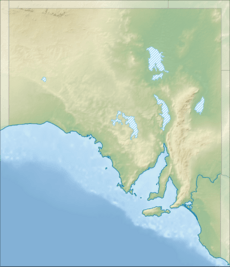Talapar Conservation Park facts for kids
Quick facts for kids Talapar Conservation ParkSouth Australia |
|
|---|---|
|
IUCN Category III (Natural Monument)
|
|
| Nearest town or city | Padthaway |
| Established | 2 June 1977 |
| Area | 4.82 km2 (1.9 sq mi) |
| Visitation | ‘little visitor use’ (in 1992) |
| Managing authorities | Department for Environment and Water |
| See also | Protected areas of South Australia |
Talapar Conservation Park is a special place in South Australia. It's a protected area where nature is kept safe. You can find it in a region called the Limestone Coast.
The park is near a town called Keppoch. It's about 40 kilometers (25 miles) north-west of Naracoorte.
What is Talapar Conservation Park?
Talapar Conservation Park was created to protect its unique environment. It covers an area of 4.82 square kilometers (about 1.86 square miles). This park was officially set up on June 2, 1977. It was created under a law called the National Parks and Wildlife Act 1972.
Why is it a Protected Area?
This park is important for protecting nature. It is classified as an IUCN Category III protected area. This means it's recognized internationally for protecting natural features.
What is the Land Like?
In 1992, experts looked closely at the park's land. They found that some small, connected wet areas had become much smaller. This happened because of drainage systems in the region. There were ideas to restore these wet areas. This could be done with some small earthworks on the northern side of the park.
What are the Soils Like?
The soil in Talapar Conservation Park is interesting. In areas that drain well, the soil is sandy and a bit shallow. It's also alkaline, which means it's not acidic. In areas that don't drain well, the soil is different. It's deep, black, and has cracks. This type of soil is called "self-mulching" because it breaks down on its own.
What Plants Grow Here?
In 1992, five main types of plant groups were found in the park. These groups are called "vegetation associations." They show how different plants grow together.
- Yellow Gum Woodlands: One area has many South Australian blue gum trees. These trees form a woodland.
- Brown Stringybark Forests: Another part of the park has a "low open forest" or "low woodland." Here, you'll find brown stringybark trees.
- Heathlands: There are also areas with "closed heath" or "open heath." These are bushy areas with plants like Melaleuca neglecta, broombush, and Leptospermum juniperinum.
- Pink Gum Woodlands: Some areas have a "low woodland" or "low open woodland." These spots feature pink gum trees. Sometimes, they grow with a heath understorey. Other times, pink gum and South Australian blue gum grow together over broombush.
- Swamp Paperbark Scrubs: Finally, there's an "open scrub" or "low open forest." This area has South Australian swamp paperbark trees. They grow with a "closed sedgeland" of plants like Machaerina Juncea, Chorizandra enodis, Lepidosperma laterale, and Leptocarpus brownii.
Visiting the Park
As of 1992, not many people visited Talapar Conservation Park. Because of this, there were no special facilities for visitors. There were only vehicle tracks around the edge of the park. These tracks were about 5 meters (16 feet) wide. They allowed access when the area sometimes flooded.


